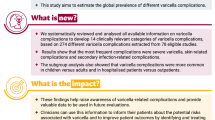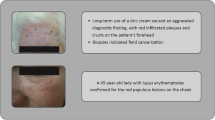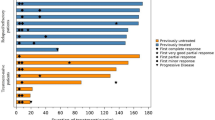Abstract
Purpose
The clinical relevance of IgE-deficiency is not established. Previous studies have postulated a relationship between absent serum IgE and the incidence of specific malignancies. We sought to examine the relationship between undetectable total serum IgE (< 3 IU/mL) and first malignancy, considering both general all-cause malignancy risk and risk of specific malignancy subtypes in adult subjects.
Methods
Retrospective cohort study at a single center of 39,965 adults aged 18 or older (median age 51, 65.1% female) with at least one serum total IgE measurement from 1998 to 2020. Analytics included chi2 table and logistic regression modeling of the main outcome measures, which include diagnosis of first malignancy and first diagnosis of specific malignancy subtype.
Results
Of the entire cohort, 2584 subjects (6.5%) developed a first malignancy and 2516 (6.3%) had an undetectable IgE. Of those with undetectable IgE levels, 8.9% developed a first malignancy versus 6.3% with detectable IgE measurements. After adjusting for risk factors, there was a significant association between undetectable IgE and risk/hazard of first malignancy (relative risk 1.49, 95% confidence interval (CI) 1.27–1.75) (hazard ratio 1.28, 95% CI 1.08–1.52). Results were similar in multiple sensitivity analyses. For type of malignancy developed, undetectable IgE was associated with increased risk of hematologic malignancy (relative risk 2.07, 95% CI 1.29–3.30) and skin malignancy (relative risk 1.52, 95% CI 1.13–2.05).
Conclusion
Compared to individuals with detectable IgE levels, patients with undetectable total serum IgE had increased risk and hazard of first malignancy in general, and increased risk of hematologic malignancy in particular.


Similar content being viewed by others
References
Lynch NR, Hagel IA, Palenque ME, Di Prisco MC, Escudero JE, Alejandra Corao L, et al. Relationship between helminthic infection and IgE response in atopic and nonatopic children in a tropical environment. J Allergy Clin Immunol. 1998;101:217–21.
Smith JK, Krishnaswamy GH, Dykes R, Reynolds S, Berk SL. Clinical manifestations of IgE hypogammaglobulinemia. Ann Allergy Asthma Immunol. Am College Allergy, Asthma Immunol. 1997;78:313–8.
Ammann AJ, Cain WA, Ishizaka K, Hong R, Good RA. Immunoglobulin E deficiency in ataxia-telangiectasia. N Engl J Med. 1969;281:469–72.
Schoettler J, Schleissner LA. Familial lgE deficiency associated sinopulmonary disease * with chest. The American College of Chest Physicians. 1989;96:516–21.
Levy DA, Chen J. Healthy IgE-deficient person. N Engl J Med. 1970;
Levin TA, Ownby DR, Smith PH, Peterson EL, Williams LK, Ford J, et al. Relationship between extremely low total serum IgE levels and rhinosinusitis. Ann Allergy, Asthma Immunol Am College Allergy, Asthma Immunol. 2006;97:650–2.
Jensen-Jarolim E, Achatz G, Turner MC, Karagiannis S, Legrand F, Capron M, et al. AllergoOncology: the role of IgE-mediated allergy in cancer. Allergy Eur. J. Allergy Clin. Immunol. 2008. p. 1255–66.
Josephs DH, Corrigan CJ, Gould HJ, Karagiannis SN. Epidemiological associations of allergy, IgE and cancer. Clin Exp Allergy. 2013;43.
Cui Y, Hill AW. Atopy and specific cancer sites: a review of epidemiological studies. Clin Rev Allergy Immunol. 2016;51:338–52.
Helby J, Bojesen SE, Nielsen SF, Nordestgaard BG. IgE and risk of cancer in 37 747 individuals from the general population. Ann Oncol Elsevier Masson SAS. 2015;26:1784–90.
Wulaningsih W, Holmberg L, Garmo H, Karagiannis SN, Ahlstedt S, Malmstrom H, et al. Investigating the association between allergen-specific immunoglobulin E, cancer risk and survival. Oncoimmunology. 2016;5.
Crawford G, Hayes MD, Seoane RC, Ward S, Dalessandri T, Lai C, et al. Epithelial damage and tissue γδ T cells promote a unique tumor-protective IgE response. Nat Immunol. Springer US; 2018;19:859–70.
Nigro EA, Brini AT, Yenagi VA, Ferreira LM, Achatz-Straussberger G, Ambrosi A, et al. Cutting edge: IgE plays an active role in tumor immunosurveillance in mice. J Immunol. 2016;197:2583–8.
Platzer B, Elpek KG, Cremasco V, Baker K, Stout MM, Schultz C, et al. IgE/FcεRI-mediated antigen cross-presentation by dendritic cells enhances anti-tumor immune responses. Cell Rep. 2015;10:1487–95.
Magen E, Schlesinger M, David M, Ben-Zion I, Vardy D. Selective IgE deficiency, immune dysregulation, and autoimmunity. Allergy Asthma Proc United States. 2014;35:e27–33.
Ferastraoaru D, Gross R, Rosenstreich D. Increased malignancy incidence in IgE deficient patients not due to concomitant common variable immunodeficiency. Ann Allergy, Asthma Immunol. 2017;119:267–73.
Ferastraoaru D, Rosenstreich D. IgE deficiency and prior diagnosis of malignancy: results of the 2005–2006 National Health and Nutrition Examination Survey. Ann Allergy, Asthma Immunol. 2018;121:613–8.
Ferastraoaru D, Rosenstreich D. IgE deficiency is associated with high rates of new malignancies: results of a longitudinal cohort study. J Allergy Clin Immunol Pract Am Academy Allergy, Asthma Immunol. 2020;8:413–5.
Zou G. A modified Poisson regression approach to prospective studies with binary data. Am J Epidemiol. 2004;159:702–6.
Ferastraoaru D, Jordakieva G, Jensen-Jarolim E. The other side of the coin: IgE deficiency, a susceptibility factor for malignancy occurrence. World Allergy Organ J. 2021;14:100505 (Elsevier Inc).
Jensen-Jarolim E, Bax HJ, Bianchini R, Capron M, Corrigan C, Castells M, et al. AllergoOncology – the impact of allergy in oncology: EAACI position paper. Allergy Eur J Allergy Clin Immunol. 2017;72:866–87.
Karagiannis P, Singer J, Hunt J, Gan SKE, Rudman SM, Mechtcheriakova D, et al. Characterisation of an engineered trastuzumab IgE antibody and effector cell mechanisms targeting HER2/neu-positive tumour cells. Cancer Immunol Immunother. 2009;58:915–30.
Spillner E, Plum M, Blank S, Miehe M, Singer J, Braren I. Recombinant IgE antibody engineering to target EGFR. Cancer Immunol Immunother. 2012. p. 1565–73.
Pellizzari G, Hoskin C, Crescioli S, Mele S, Gotovina J, Chiaruttini G, et al. IgE re-programs alternatively-activated human macrophages towards pro-inflammatory anti-tumoural states. EBioMedicine The Authors. 2019;43:67–81.
World Cancer Research Fund. Cancer facts and figures [Internet]. World Cancer Res. Fund Int. 2021. p. 1–4. Available from: http://www.wcrf.org/int/cancer-facts-figures/worldwide-data
Adcock IM. Cancers related to immunodeficiencies : Update and Perspectives. 2016;7:1–13
Acknowledgements
The authors would like to acknowledge the efforts of Robert Burton, Business Intelligence at the Cleveland Clinic, for database analytics.
Author information
Authors and Affiliations
Contributions
All authors have approved the final version to be published and are accountable for the work. Authors contributed to the following aspects of the manuscript as outlined:
KW: data acquisition, data analysis, and interpretation; contribution to the first draft and editing of the final draft
JM: data acquisition, statistical analyses, data analysis, and interpretation, contribution to the first draft and editing of the final draft
JA: data analysis, statistical analysis, interpretation of data, revisions for intellectual content
MS: data analysis, statistical analysis, interpretation of data, revisions for intellectual content
FH: IRB project approval, data acquisition, data analysis and interpretation, revisions of all drafts for intellectual content, editing of the final draft
Corresponding author
Ethics declarations
Ethics Approval
This retrospective chart review was approved by the Cleveland Clinic Institutional Review Board (IRB).
Consent to Participate
Not applicable
Consent for Publication
Not applicable
Conflict of Interest
The authors declare no competing interests.
Additional information
Publisher's Note
Springer Nature remains neutral with regard to jurisdictional claims in published maps and institutional affiliations.
Supplementary Information
Below is the link to the electronic supplementary material.
Rights and permissions
Springer Nature or its licensor (e.g. a society or other partner) holds exclusive rights to this article under a publishing agreement with the author(s) or other rightsholder(s); author self-archiving of the accepted manuscript version of this article is solely governed by the terms of such publishing agreement and applicable law.
About this article
Cite this article
Weller, K.N., McDonnell, J.C., Albert, J.M. et al. Increased Hazard Risk of First Malignancy in Adults with Undetectable Serum IgE: a Retrospective Cohort Study. J Clin Immunol 43, 568–577 (2023). https://doi.org/10.1007/s10875-022-01401-7
Received:
Accepted:
Published:
Issue Date:
DOI: https://doi.org/10.1007/s10875-022-01401-7




